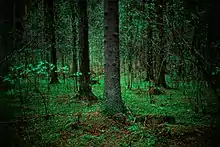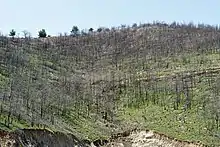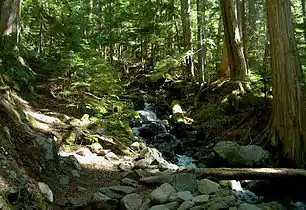Forest
A forest is an area of land dominated by trees.[1] Hundreds of definitions of forest are used throughout the world, incorporating factors such as tree density, tree height, land use, legal standing and ecological function.[2][3][4] The Food and Agriculture Organization defines a forest as land spanning more than 0.5 hectares with trees higher than 5 meters and a canopy cover of more than 10 percent, or trees able to reach these thresholds in situ. It does not include land that is predominantly under agricultural or urban land use.[5] Using this definition FRA 2020 found that forests covered 4.06 billion hectares or approximately 31 percent of the global land area in 2020 but are not equally distributed around the globe.[6]
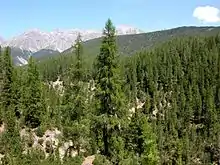
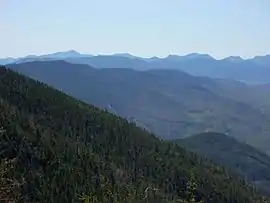
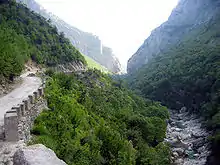
Forests are the dominant terrestrial ecosystem of Earth, and are distributed around the globe.[7] More than half of the world’s forests are found in only five countries (Brazil, Canada, China, Russian Federation and United States of America). The largest part of the forest (45 percent) is found in the tropical domain, followed by the boreal, temperate and subtropical domains.[8]
Forests account for 75% of the gross primary production of the Earth's biosphere, and contain 80% of the Earth's plant biomass. Net primary production is estimated at 21.9 gigatonnes carbon per year for tropical forests, 8.1 for temperate forests, and 2.6 for boreal forests.[7]
Forests at different latitudes and elevations, and with different precipitation and evapotranspiration[9] form distinctly different biomes: boreal forests around the North Pole, tropical moist forests and tropical dry forests around the Equator, and temperate forests at the middle latitudes. Higher elevation areas tend to support forests similar to those at higher latitudes, and amount of precipitation also affects forest composition.
Almost half the forest area (49 percent) is relatively intact, while 9 percent is found in fragments with little or no connectivity. Tropical rainforests and boreal coniferous forests are the least fragmented, whereas subtropical dry forest and temperate oceanic forests are among the most fragmented. Roughly 80 percent of the world’s forest area is found in patches larger than 1 million hectares. The remaining 20 percent is located in more than 34 million patches across the world – the vast majority less than 1 000 hectares in size.[10]
Human society and forests influence each other in both positive and negative ways.[11] Forests provide ecosystem services to humans and serve as tourist attractions. Forests can also affect people's health. Human activities, including unsustainable use of forest resources, can negatively affect forest ecosystems.
Definition
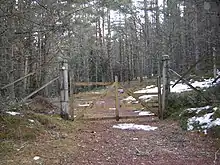
Although the word forest is commonly used, there is no universally recognised precise definition, with more than 800 definitions of forest used around the world.[4] Although a forest is usually defined by the presence of trees, under many definitions an area completely lacking trees may still be considered a forest if it grew trees in the past, will grow trees in the future,[12] or was legally designated as a forest regardless of vegetation type.[13][14]
There are three broad categories of forest definitions in use: administrative, land use, and land cover.[13] Administrative definitions are based primarily upon the legal designations of land, and commonly bear little relationship to the vegetation growing on the land: land that is legally designated as a forest is defined as a forest even if no trees are growing on it.[13] Land use definitions are based upon the primary purpose that the land serves. For example, a forest may be defined as any land that is used primarily for production of timber. Under such a land use definition, cleared roads or infrastructure within an area used for forestry, or areas within the region that have been cleared by harvesting, disease or fire are still considered forests even if they contain no trees. Land cover definitions define forests based upon the type and density of vegetation growing on the land. Such definitions typically define a forest as an area growing trees above some threshold. These thresholds are typically the number of trees per area (density), the area of ground under the tree canopy (canopy cover) or the section of land that is occupied by the cross-section of tree trunks (basal area).[13] Under such land cover definitions, an area of land can only be known as forest if it is growing trees. Areas that fail to meet the land cover definition may be still included under while immature trees are establishing if they are expected to meet the definition at maturity.[13]
Under land use definitions, there is considerable variation on where the cutoff points are between a forest, woodland, and savanna. Under some definitions, forests require very high levels of tree canopy cover, from 60% to 100%,[15] excluding savannas and woodlands in which trees have a lower canopy cover. Other definitions consider savannas to be a type of forest, and include all areas with tree canopies over 10%.[12]
Some areas covered with trees are legally defined as agricultural areas, e.g. Norway spruce plantations in Austrian forest law when the trees are being grown as Christmas trees and below a certain height.
Etymology
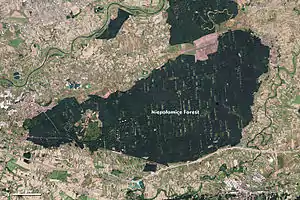
The word forest derives from the Old French forest (also forès), denoting "forest, vast expanse covered by trees"; forest was first introduced into English as the word denoting wild land set aside for hunting[17] without the necessity in definition of having trees on the land.[18] Possibly a borrowing, probably via Frankish or Old High German, of the Medieval Latin foresta, denoting "open wood", Carolingian scribes first used foresta in the Capitularies of Charlemagne specifically to denote the royal hunting grounds of the King. The word was not endemic to Romance languages, e. g. native words for forest in the Romance languages derived from the Latin silva, which denoted "forest" and "wood(land)" (confer the English sylva and sylvan); confer the Italian, Spanish, and Portuguese selva; the Romanian silvă; and the Old French selve, and cognates in Romance languages, e. g. the Italian foresta, Spanish and Portuguese floresta, etc., are all ultimately derivations of the French word.

The precise origin of Medieval Latin foresta is obscure. Some authorities claim the word derives from the Late Latin phrase forestam silvam, denoting "the outer wood"; others claim the word is a latinisation of the Frankish *forhist, denoting "forest, wooded country", and was assimilated to "forestam silvam" pursuant to the common practice of Frankish scribes. The Old High German forst denoting "forest", Middle Low German vorst denoting "forest", Old English fyrhþ denoting "forest, woodland, game preserve, hunting ground" (English frith), and Old Norse fýri, denoting "coniferous forest", all of which derive from the Proto-Germanic *furhísa-, *furhíþija-, denoting "a fir-wood, coniferous forest", from the Proto-Indo-European *perkwu-, denoting "a coniferous or mountain forest, wooded height" all attest to the Frankish *forhist.
Uses of forest in English to denote any uninhabited and unenclosed area presently are considered archaic.[19] The Norman rulers of England introduced the word as a legal term, as seen in Latin texts such as the Magna Carta, to denote uncultivated land that was legally designated for hunting by feudal nobility (see Royal Forest).[19][20]
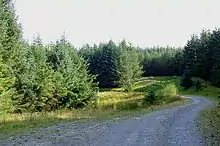
These hunting forests did not necessarily contain many, if any, trees. However, because hunting forests often included significant areas of woodland, forest eventually came to connote woodland in general, regardless of the density of the trees. By the beginning of the Fourteenth Century, English texts used the word in all three of its senses: common, legal, and archaic.[19] Other English words used to denote "an area with a high density of trees" are firth, frith, holt, weald, wold, wood, and woodland. Unlike forest, these are all derived from Old English and were not borrowed from another language. Some present classifications reserve woodland for denoting a locale with more open space between trees, and distinguish kinds of woodlands as open forests and closed forests premised on their crown covers.[21] Finally, sylva (plural sylvae or, less classically, sylvas) is a peculiar English spelling of the Latin silva, denoting a "woodland", and has precedent in English, including its plural forms. While its use as a synonym of forest and as a Latinate word denoting a woodland may be admitted, in a specific technical sense it is restricted to denoting the species of trees that comprise the woodlands of a region, as in its sense in the subject of silviculture.[22] The resorting to sylva in English indicates more precisely the denotation that use of forest intends.
Evolutionary history
The first known forests on Earth arose in the Late Devonian (approximately 380 million years ago), with the evolution of Archaeopteris.[23] Archaeopteris was a plant that was both tree-like and fern-like, growing to 10 metres (33 ft) in height. Archaeopteris quickly spread throughout the world, from the equator to subpolar latitudes.[23] Archaeopteris formed the first forest by being the first known species to cast shade due to its fronds and forming soil from its roots. Archaeopteris was deciduous, dropping its fronds onto the forest floor. The shade, soil, and forest duff from the dropped fronds created the first forest.[23] The shed organic matter altered the freshwater environment, slowing it down and providing food. This promoted freshwater fish.[23]
Ecology
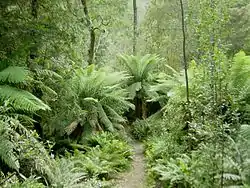
Forests account for 75% of the gross primary productivity of the Earth's biosphere, and contain 80% of the Earth's plant biomass.[7]
The world's forests contain about 606 gigatonnes of living biomass (above- and below-ground) and 59 gigatonnes of dead wood. The total biomass has decreased slightly since 1990 but biomass per unit area has increased.[24]
Forest ecosystems can be found in all regions capable of sustaining tree growth, at altitudes up to the tree line, except where natural fire frequency or other disturbance is too high, or where the environment has been altered by human activity.
The latitudes 10° north and south of the equator are mostly covered in tropical rainforest, and the latitudes between 53°N and 67°N have boreal forest. As a general rule, forests dominated by angiosperms (broadleaf forests) are more species-rich than those dominated by gymnosperms (conifer, montane, or needleleaf forests), although exceptions exist.
Forests sometimes contain many tree species within a small area (as in tropical rain and temperate deciduous forests), or relatively few species over large areas (e.g., taiga and arid montane coniferous forests). Forests are often home to many animal and plant species, and biomass per unit area is high compared to other vegetation communities. Much of this biomass occurs below ground in the root systems and as partially decomposed plant detritus. The woody component of a forest contains lignin, which is relatively slow to decompose compared with other organic materials such as cellulose or carbohydrate.
The biodiversity of forests varies considerably according to factors such as forest type, geography, climate and soils – in addition to human use.[25] Most forest habitats in temperate regions support relatively few animal and plant species and species that tend to have large geographical distributions, while the montane forests of Africa, South America and Southeast Asia and lowland forests of Australia, coastal Brazil, the Caribbean islands Central America and insular Southeast Asia have many species with small geographical distributions.[25] Areas with dense human populations and intense agricultural land use, such as Europe, parts of Bangladesh, China, India and North America, are less intact in terms of their biodiversity.[25] Northern Africa, southern Australia, coastal Brazil, Madagascar and South Africa, are also identified as areas with striking losses in biodiversity intactness.[25]
Components

A forest consists of many components that can be broadly divided into two categories that are biotic (living) and abiotic (non-living) components. The living parts include trees, shrubs, vines, grasses and other herbaceous (non-woody) plants, mosses, algae, fungi, insects, mammals, birds, reptiles, amphibians, and microorganisms living on the plants and animals and in the soil.
Layers
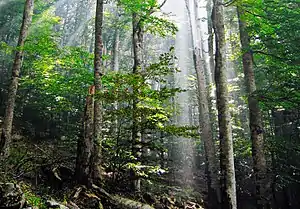
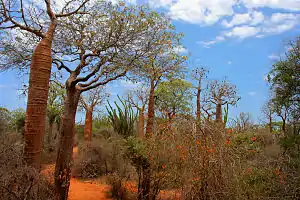
A forest is made up of many layers. The main layers of all forest types are the forest floor, the understory and the canopy. The emergent layer exists in tropical rainforests. Each layer has a different set of plants and animals depending upon the availability of sunlight, moisture and food.
- Forest floor contains decomposing leaves, animal droppings, and dead trees. Decay on the forest floor forms new soil and provides nutrients to the plants. The forest floor supports ferns, grasses, mushroom and tree seedlings.
- Understory is made up of bushes, shrubs, and young trees that are adapted to living in the shades of the canopy.
- Canopy is formed by the mass of intertwined branches, twigs and leaves of the mature trees. The crowns of the dominant trees receive most of the sunlight. This is the most productive part of the trees where maximum food is produced. The canopy forms a shady, protective "umbrella" over the rest of the forest.
- Emergent layer exists in the tropical rain forest and is composed of a few scattered trees that tower over the canopy.[26]
However, in botany and many countries (Germany, Poland, etc.), a different classification of forest vegetation structure is often used: tree, shrub, herb and moss layers, see stratification (vegetation).
Types
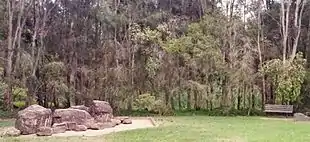

Forests can be classified in different ways and to different degrees of specificity. One such way is in terms of the biome in which they exist, combined with leaf longevity of the dominant species (whether they are evergreen or deciduous). Another distinction is whether the forests are composed predominantly of broadleaf trees, coniferous (needle-leaved) trees, or mixed.
- Boreal forests occupy the subarctic zone and are generally evergreen and coniferous.
- Temperate zones support both broadleaf deciduous forests (e.g., temperate deciduous forest) and evergreen coniferous forests (e.g., temperate coniferous forests and temperate rainforests). Warm temperate zones support broadleaf evergreen forests, including laurel forests.
- Tropical and subtropical forests include tropical and subtropical moist forests, tropical and subtropical dry forests, and tropical and subtropical coniferous forests.
- Physiognomy classifies forests based on their overall physical structure or developmental stage (e.g. old growth vs. second growth).
- Forests can also be classified more specifically based on the climate and the dominant tree species present, resulting in numerous different forest types (e.g., Ponderosa pine/Douglas-fir forest).
The number of trees in the world, according to a 2015 estimate, is 3 trillion, of which 1.4 trillion are in the tropics or sub-tropics, 0.6 trillion in the temperate zones, and 0.7 trillion in the coniferous boreal forests. The estimate is about eight times higher than previous estimates, and is based on tree densities measured on over 400,000 plots. It remains subject to a wide margin of error, not least because the samples are mainly from Europe and North America.[28]
Forests can also be classified according to the amount of human alteration. Old-growth forest contains mainly natural patterns of biodiversity in established seral patterns, and they contain mainly species native to the region and habitat. In contrast, secondary forest is regrowing forest following timber harvest and may contain species originally from other regions or habitats.[29]
Different global forest classification systems have been proposed, but none has gained universal acceptance.[30] UNEP-WCMC's forest category classification system is a simplification of other more complex systems (e.g. UNESCO's forest and woodland 'subformations'). This system divides the world's forests into 26 major types, which reflect climatic zones as well as the principal types of trees. These 26 major types can be reclassified into 6 broader categories: temperate needleleaf; temperate broadleaf and mixed; tropical moist; tropical dry; sparse trees and parkland; and forest plantations.[30] Each category is described as a separate section below.
Temperate needleleaf
Temperate needleleaf forests mostly occupy the higher latitude regions of the Northern Hemisphere, as well as high altitude zones and some warm temperate areas, especially on nutrient-poor or otherwise unfavourable soils. These forests are composed entirely, or nearly so, of coniferous species (Coniferophyta). In the Northern Hemisphere pines Pinus, spruces Picea, larches Larix, firs Abies, Douglas firs Pseudotsuga and hemlocks Tsuga, make up the canopy, but other taxa are also important. In the Southern Hemisphere, most coniferous trees (members of the Araucariaceae and Podocarpaceae) occur in mixtures with broadleaf species, and are classed as broadleaf and mixed forests.[30]
Temperate broadleaf and mixed
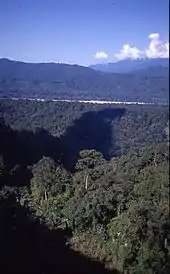
Temperate broadleaf and mixed forests include a substantial component of trees in the Anthophyta. They are generally characteristic of the warmer temperate latitudes, but extend to cool temperate ones, particularly in the southern hemisphere. They include such forest types as the mixed deciduous forests of the United States and their counterparts in China and Japan, the broadleaf evergreen rainforests of Japan, Chile and Tasmania, the sclerophyllous forests of Australia, central Chile, the Mediterranean and California, and the southern beech Nothofagus forests of Chile and New Zealand.[30]
Tropical moist
There are many different types of tropical moist forests, with lowland evergreen broad leaf tropical rainforests, for example várzea and igapó forests and the terra firma forests of the Amazon Basin; the peat swamp forests, dipterocarp forests of Southeast Asia; and the high forests of the Congo Basin. Seasonal tropical forests, perhaps the best description for the colloquial term "jungle", typically range from the rainforest zone 10 degrees north or south of the equator, to the Tropic of Cancer and Tropic of Capricorn. Forests located on mountains are also included in this category, divided largely into upper and lower montane formations on the basis of the variation of physiognomy corresponding to changes in altitude.[31]
Tropical dry
Tropical dry forests are characteristic of areas in the tropics affected by seasonal drought. The seasonality of rainfall is usually reflected in the deciduousness of the forest canopy, with most trees being leafless for several months of the year. However, under some conditions, e.g. less fertile soils or less predictable drought regimes, the proportion of evergreen species increases and the forests are characterised as "sclerophyllous". Thorn forest, a dense forest of low stature with a high frequency of thorny or spiny species, is found where drought is prolonged, and especially where grazing animals are plentiful. On very poor soils, and especially where fire or herbivory are recurrent phenomena, savannas develop.[30]
Sparse trees and parkland
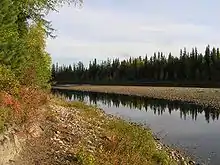
Sparse trees and savanna are forests with lower canopy cover of trees. They occur principally in areas of transition from forested to non-forested landscapes. The two major zones in which these ecosystems occur are in the boreal region and in the seasonally dry tropics. At high latitudes, north of the main zone of boreal forest, growing conditions are not adequate to maintain a continuous closed forest cover, so tree cover is both sparse and discontinuous. This vegetation is variously called open taiga, open lichen woodland, and forest tundra. A savanna is a mixed woodland grassland ecosystem characterized by the trees being sufficiently widely spaced so that the canopy does not close. The open canopy allows sufficient light to reach the ground to support an unbroken herbaceous layer consisting primarily of grasses. Savannas maintain an open canopy despite a high tree density.[30]
Forest plantations
Forest plantations are generally intended for the production of timber and pulpwood. Commonly mono-specific, planted with even spacing between the trees, and intensively managed, these forests are not generally important as habitat for native biodiversity. However, they can be managed in ways that enhance their biodiversity protection functions and they can provide ecosystem services such as maintaining nutrient capital, protecting watersheds and soil structure, and storing carbon.[29][30]
Forest area
The net loss of forest area has decreased substantially since 1990, but the world is not on track to meet the target of the United Nations Strategic Plan for Forests to increase forest area by 3 percent by 2030.[25]
While deforestation is taking place in some areas, new forests are being established through natural expansion or deliberate efforts in others. As a result, the net loss of forest area is less than the rate of deforestation and it too is decreasing: from 7.8 million hectares per year in the 1990s to 4.7 million hectares per year during 2010– 2020.[25] In absolute terms, the global forest area decreased by 178 million hectares between 1990 and 2020, which is an area about the size of Libya.[25]
Societal significance
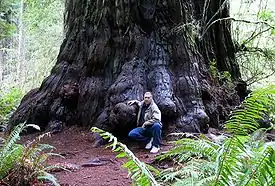
Forests provide a diversity of ecosystem services including:
- converting carbon dioxide into oxygen and biomass. A full-grown tree produces about 100 kg of net oxygen per year.[32]
- acting as a carbon sink. Therefore, they are necessary to mitigate climate change. According to the Special Report on Global Warming of 1.5 °C of the Intergovernmental Panel on Climate Change, to avoid temperature rise by more than 1.5 degrees above pre-industrial levels, there will need to be an increase in global forest cover equal to the land area of Canada (10 million km2), by the year 2050.[33]
- aiding in regulating climate. For example, a research from 2017, show that forests induce rainfall. If the forest is cut, it can lead to drought.[34]
- purifying water.
- mitigating natural hazards such as floods.
- serving as a genetic reserve.
- serving as a source of lumber and as recreational areas.
- Serving as a source of woodlands and trees for millions of people depending almost entirely on forests for subsistence for their essential fuelwood, food and fodder needs.[35]
Some researchers state that forests do not only provide benefits, but can in certain cases also incur costs to humans.[36][37] Forests may impose an economic burden,[38][39] diminish the enjoyment of natural areas,[40] reduce the food producing capacity of grazing land[41] and cultivated land,[42] reduce biodiversity[43][44] reduce available water for humans and wildlife,[45][46] harbour dangerous or destructive wildlife,[36][47] and act as reservoirs of human and livestock disease.[48][49]
The management of forests is often referred to as forestry. Forest management has changed considerably over the last few centuries, with rapid changes from the 1980s onwards culminating in a practice now referred to as sustainable forest management. Forest ecologists concentrate on forest patterns and processes, usually with the aim of elucidating cause-and-effect relationships. Foresters who practice sustainable forest management focus on the integration of ecological, social, and economic values, often in consultation with local communities and other stakeholders.

Humans have generally decreased the amount of forest worldwide. Anthropogenic factors that can affect forests include logging, urban sprawl, human-caused forest fires, acid rain, invasive species, and the slash and burn practices of swidden agriculture or shifting cultivation. The loss and re-growth of forest leads to a distinction between two broad types of forest, primary or old-growth forest and secondary forest. There are also many natural factors that can cause changes in forests over time including forest fires, insects, diseases, weather, competition between species, etc. In 1997, the World Resources Institute recorded that only 20% of the world's original forests remained in large intact tracts of undisturbed forest.[50] More than 75% of these intact forests lie in three countries—the boreal forests of Russia and Canada and the rainforest of Brazil.
According to FAO's Global Forest Resources Assessment 2020, an estimated 420 million hectares of forest has been lost worldwide through deforestation since 1990, but the rate of forest loss has declined substantially. In the most recent five-year period (2015–2020), the annual rate of deforestation was estimated at 10 million hectares, down from 12 million hectares in 2010–2015.[24]
China instituted a ban on logging, beginning in 1998, due to the erosion and flooding that it caused.[51] In addition, ambitious tree planting programmes in countries such as China, India, the United States and Vietnam – combined with natural expansion of forests in some regions – have added more than seven million hectares of new forests annually. As a result, the net loss of forest area was reduced to 5.2 million hectares per year between 2000 and 2010, down from 8.3 million hectares annually in the 1990s. In 2015, a study for Nature Climate Change showed that the trend has recently been reversed, leading to an "overall gain" in global biomass and forests. This gain is due especially to reforestation in China and Russia.[52] However new forests are not completely equivalent to old growth forests in terms of species diversity, resilience and carbon capture. On 7 September 2015, the Food and Agriculture Organization of the United Nations released a new study stating that, over the last 25 years, the global deforestation rate has decreased by 50% due to improved management of forests and greater government protection.[53][54]

There is an estimated 726 million ha of forest in protected areas worldwide. Of the six major world regions, South America has the highest share of forests in protected areas, at 31 percent. The area of forest in protected areas globally has increased by 191 million ha since 1990, but the rate of annual increase slowed in 2010–2020.[56]
Smaller areas of woodland in cities may be managed as urban forestry, sometimes within public parks. These are often created for human benefits; Attention Restoration Theory argues that spending time in nature reduces stress and improves health, while forest schools and kindergartens help young people to develop social as well as scientific skills in forests. These typically need to be close to where the children live, for practical logistics.
Canada
Canada has about 4,020,000 square kilometres (1,550,000 sq mi) of forest land. More than 90% of forest land is publicly owned and about 50% of the total forest area is allocated for harvesting. These allocated areas are managed using the principles of sustainable forest management, which includes extensive consultation with local stakeholders. About eight percent of Canada's forest is legally protected from resource development.[57][58] Much more forest land—about 40 percent of the total forest land base—is subject to varying degrees of protection through processes such as integrated land use planning or defined management areas such as certified forests.[58]
By December 2006, over 1,237,000 square kilometres of forest land in Canada (about half the global total) had been certified as being sustainably managed.[59] Clearcutting, first used in the latter half of the 20th century, is less expensive, but devastating to the environment, and companies are required by law to ensure that harvested areas are adequately regenerated. Most Canadian provinces have regulations limiting the size of clear-cuts, although some older clear-cuts can range upwards of 110 square kilometres (27,000 acres) in size which was cut over several years.
Latvia
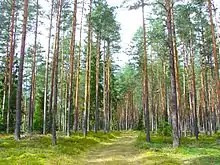
Latvia has about 3,270,000 hectares (12,626 sq mi) of forest land which equates to 50.6% of Latvia's total area (24,938 sq mi). 1,510,000 hectares of forest land (46.3% of total forest land) is publicly owned and 1,750,000 hectares of forest land (53.7% of total forest land) is in private hands. Latvia's forests have been steadily increasing over the years which is in contrast to many other nations, mostly due to the forestation of land not used for agriculture. In 1935 there was only 1,757,000 hectares of forest, today this has increased by more than 150%. Birch is the most common tree at 28.2% followed by pine (26,9%), spruce (18.3%), grey alder (9.7%), aspen (8,0%), black alder (5.7%), oak/ash (1.2%) and finally hardwood making up the rest (2.0%).[60][61]
United States
In the United States, most forests have historically been affected by humans to some degree, though in recent years improved forestry practices have helped regulate or moderate large scale or severe impacts. However, the United States Forest Service estimates a net loss of about 2 million hectares (4,942,000 acres) between 1997 and 2020; this estimate includes conversion of forest land to other uses, including urban and suburban development, as well as afforestation and natural reversion of abandoned crop and pasture land to forest. However, in many areas of the United States, the area of forest is stable or increasing, particularly in many northern states. The opposite problem from flooding has plagued national forests, with loggers complaining that a lack of thinning and proper forest management has resulted in large forest fires.[62][63]
Largest forests in the world
| Forest | Area | Countries |
|---|---|---|
| Amazon rainforest | 5,500,000 km2 (2,100,000 sq mi) | Brazil, Peru, Colombia, Bolivia, Ecuador, French Guiana, Guyana, Suriname, Venezuela |
| Congo Rainforest | 2,000,000 km2 (770,000 sq mi) | Angola, Cameroon, Central African Republic, Democratic Republic of the Congo, Republic of the Congo, Equatorial Guinea, Gabon |
| Atlantic Forest | 1,315,460 km2 (507,900 sq mi) | Brazil, Argentina, Paraguay |
| Valdivian Temperate Rainforest | 248,100 km2 (95,800 sq mi) | Chile, Argentina |
| Tongass National Forest | 68,000 km2 (26,000 sq mi) | United States |
| Rainforest of Xishuangbanna | 19,223 km2 (7,422 sq mi) | China |
| Sunderbans | 10,000 km2 (3,900 sq mi) | India, Bangladesh |
| Daintree Rainforest | 1,200 km2 (460 sq mi) | Australia |
| Kinabalu Park | 754 km2 (291 sq mi) | Malaysia |
Forests named after their creators
Some areas of land have been reforested and named after their creators, Larose Forest,and Molai forest are two so named.
See also
- Agroforestry
- Ancient woodland, an official classification of ancient forest in the United Kingdom.
- Biomass
- Biomass (ecology)
- Bioproduct
- Biosphere
- Boreal forest
- Canopy (biology)
- Clearcutting
- Close to nature forestry
- Cloud forest
- Chase (land)
- Deforestation
- Dendrology
- Dendrometry
- Ecological succession
- Forest dynamics
- Forest management
- Forest migration
- Forest pathology
- History of the forest in Central Europe
- Illegal logging
- Intact forest landscape
- Jungle (terrain)
- Kelp forest (A forest made mostly if not entirely of Kelp; an underwater forest)
- List of countries by forest area
- List of old-growth forests
- List of superlative trees
- List of tree genera
- List of trees and shrubs by taxonomic family
- Natural environment
- Natural landscape
- Old-growth forest (ancient forest, virgin forest, primary forest)
- Orchard
- Permaforestry
- Plantation (forestry)
- Primeval forest, a term often used interchangeably with old growth forest
- REDD-plus
- Savanna
- Silviculture
- Stand level modelling
- Stratification (vegetation)
- Subalpine forest
- Taiga, a biome characterized by coniferous forests
- Temperate broadleaf and mixed forests
- Temperate coniferous forests
- Tree
- Tree allometry
- Tree farm
- Trees of the world
- Tropical rainforest
- Tropical and subtropical coniferous forests
- Tropical and subtropical moist broadleaf forests
- Wildcrafting
- Wilderness
- Woodland
- Woodland management
- Rain Forest
Sources
![]() This article incorporates text from a free content work. Licensed under CC BY-SA 3.0 License statement/permission on Wikimedia Commons. Text taken from Global Forest Resources Assessment 2020 Key findings, FAO, FAO.
This article incorporates text from a free content work. Licensed under CC BY-SA 3.0 License statement/permission on Wikimedia Commons. Text taken from Global Forest Resources Assessment 2020 Key findings, FAO, FAO.
![]() This article incorporates text from a free content work. Licensed under CC BY-SA 3.0 License statement/permission on Wikimedia Commons. Text taken from The State of the World’s Forests 2020. In brief – Forests, biodiversity and people, FAO & UNEP, FAO & UNEP.
This article incorporates text from a free content work. Licensed under CC BY-SA 3.0 License statement/permission on Wikimedia Commons. Text taken from The State of the World’s Forests 2020. In brief – Forests, biodiversity and people, FAO & UNEP, FAO & UNEP.
References
- "Forest". Dictionary.com. Archived from the original on 19 October 2014. Retrieved 16 November 2014.
- Schuck, Andreas; Päivinen, Risto; Hytönend, Tuomo; Pajari, Brita (2002). "Compilation of Forestry Terms and Definitions" (PDF). Joensuu, Finland: European Forest Institute. Archived (PDF) from the original on 5 June 2015. Retrieved 16 November 2014.
- "Definitions: Indicative definitions taken from the Report of the ad hoc technical expert group on forest biological diversity". Convention on Biological Diversity. Archived from the original on 19 December 2014. Retrieved 16 November 2014.
- "Forest definition and extent" (PDF). United Nations Environment Programme. 27 January 2010. Archived from the original (PDF) on 26 July 2010. Retrieved 16 November 2014.
- Global Forest Resources Assessment 2020 – Terms and definitions (PDF). Rome: FAO. 2018.
- The State of the World's Forests 2020. In brief – Forests, biodiversity and people. Rome: FAO & UNEP. 2020. doi:10.4060/ca8985en. ISBN 978-92-5-132707-4.
- Pan, Yude; Birdsey, Richard A.; Phillips, Oliver L.; Jackson, Robert B. (2013). "The Structure, Distribution, and Biomass of the World's Forests" (PDF). Annu. Rev. Ecol. Evol. Syst. 44: 593–62. doi:10.1146/annurev-ecolsys-110512-135914. Archived (PDF) from the original on 7 August 2016.
- The State of the World's Forests 2020. In brief – Forests, biodiversity and people. Rome, Italy: FAO & UNEP. 2020. doi:10.4060/ca8985en. ISBN 978-92-5-132707-4.
- Holdridge, L.R. Life zone ecology (PDF). San Jose, Costa Rica: Tropical Science Center.
- The State of the World's Forests 2020. In brief – Forests, biodiversity and people. Rome, Italy: FAO & UNEP. 2020. doi:10.4060/ca8985en. ISBN 978-92-5-132707-4.
- Vogt, Kristina A, ed. (2007). "Global Societies and Forest Legacies Creating Today's Forest Landscapes". Forests and Society: Sustainability and Life Cycles of Forests in Human Landscapes. CABI. pp. 30–59. ISBN 978-1-84593-098-1.
- MacDicken, Kenneth (15 March 2013). "Forest Resources Assessment Working Paper 180" (PDF). Rome: Food and Agriculture Organization of the United Nations Forestry Department. Archived (PDF) from the original on 24 September 2015. Retrieved 16 November 2014.
- Watson, Robert T.; Verardo, David J.; Noble, Ian R.; Bolin, Bert; Ravindranath, N.H.; Dokken, David J., eds. (2000). "Land Use, Land-Use Change and Forestry". Intergovernmental Panel on Climate Change. Archived from the original on 29 November 2014. Retrieved 16 November 2014.
- Menzies, Nicholas; Grinspoon, Elisabeth (22 October 2007). "Facts on Forests and Forestry". ForestFacts.org, a subsidiary of GreenFacts.org. Archived from the original on 8 May 2015. Retrieved 16 November 2014.
- "Introduction: Definition of a Forest". MuseumLink Illinois. Archived from the original on 29 October 2014. Retrieved 16 November 2014.
- "A Polish Royal Forest". NASA Earth Observatory. 29 November 2013. Archived from the original on 4 January 2014.
- "Broadsheet: The News Letter for Broadland Tree Wardens" (PDF). April 2011. Archived from the original (PDF) on 29 November 2014. Retrieved 16 November 2014.
- Ritter, E (2011). Dauksta, D (ed.). New Perspectives on People and Forests. World Forests. 9. Springer. ISBN 978-94-007-1149-5.
- "forest, noun". Oxford English Dictionary online edition. Oxford University Press. Archived from the original on 11 January 2008. Retrieved 22 May 2009.
- "forest, noun". The American Heritage Dictionary of the English Language (3 ed.). Boston: Houghton Mifflin Company. 1996. ISBN 978-0-395-44895-3.
- "What is a Forest?". Australian Government/Department of Agriculture, Fisheries, and Forestry/Rural Areas. 28 March 2007. Archived from the original on 9 October 2009. Retrieved 25 November 2010.
- Confer John Evelyn, FRS, Sylva, or A Discourse of Forest-Trees and the Propagation of Timber in His Majesty's Dominions (1664); and the title of and use passim in Edward Step, FLS, Wayside and Woodland Trees: A Pocket Guide to the British Sylva (Frederick Warne and Company Limited, London and New York, [many editions]).
- "The First Forests". Devonian Times. Archived from the original on 10 May 2016. Retrieved 28 May 2016.
- Global Forest Resources Assessment 2020 – Key findings. Rome: FAO. 2020. doi:10.4060/ca8753en. ISBN 978-92-5-132581-0.
- The State of the World's Forests 2020. Forests, biodiversity and people – In brief. Rome: FAO & UNEP. 2020. doi:10.4060/ca8985en. ISBN 978-92-5-132707-4.
- The Living World. D.A.V. College Managing Committee.
- Global Forest Resources Assessment 2020 – Key findings. Rome: FAO. 2020. doi:10.4060/ca8753en. ISBN 978-92-5-132581-0.
- Amos, Jonathan (3 September 2015). "Earth's trees number 'three trillion'". BBC. Archived from the original on 3 September 2015. Retrieved 3 September 2015.
- Chazdon, Robin L. (2008). "Beyond deforestation: restoring forests and ecosystem services on degraded lands" (PDF). Science. 320 (5882): 1458–60. Bibcode:2008Sci...320.1458C. doi:10.1126/science.1155365. PMID 18556551. S2CID 206511664. Archived (PDF) from the original on 21 October 2016.
- Jenkins, Martin D.; Groombridge, Brian (2002). World Atlas of Biodiversity: Earth's Living Resources in the 21st Century. World Conservation Monitoring Centre, United Nations Environment Programme. ISBN 978-0-520-23668-4.
- Chape, S; Spalding, M; Jenkins, M (2008). The world's protected areas: status, values and prospects in the 21st century. Univ de Castilla La Mancha. ISBN 978-0-520-24660-7.
- Luis Villazon. "How many trees does it take to produce oxygen for one person?". Science Focus. Retrieved 12 August 2019.
- GLOBAL WARMING OF 1.5 °C an IPCC special report on the impacts of global warming of 1.5 °C above pre-industrial levels and related global greenhouse gas emission pathways, in the context of strengthening the global response to the threat of climate change, sustainable development, and efforts to eradicate poverty Summary for Policymakers (PDF). Intergovernmental Panel on Climate Change. 6 October 2018. p. 22. Retrieved 18 October 2018.
- S. Write, Jonathon; Fu, Rong; R. Worden, John; Chakraborty, Sudip; E. Clinton, Nicholas; Risi, Camille; Sun, Ying; Yin, Lei (20 July 2017). "Rainforest-initiated wet season onset over the southern Amazon". Proceedings of the National Academy of Sciences of the United States of America. 114 (Forests, Rainfall): 8481–86. Bibcode:2017PNAS..114.8481W. doi:10.1073/pnas.1621516114. PMC 5558997. PMID 28729375. Retrieved 12 July 2018.
- The State of the World's Forests 2020 – Forests, biodiversity and people. Rome: FAO & UNEP. 2020. doi:10.4060/ca8642en. ISBN 978-92-5-132419-6.
- Nasi, R; Wunder, S; Campos A, JJ (11 March 2002). "Forest ecosystem services: can they pay our way out of deforestation?" (PDF). UNFF II. Costa Rica. Archived (PDF) from the original on 4 December 2014.
- Emerton, Lucy (1999). Mount Kenya: The Economics of Community Conservation (PDF) (Community Conservation research Working Paper). Evaluating Eden Series. University of Manchester Institute of Development Policy and Management. Archived (PDF) from the original on 4 December 2014.
- de Boo, Henneleen, Lette, Henk (2002). "Economic Valuation of Forests and Nature A support tool for effective decision-making". Theme Studies Series 6 Forests. Ede, The Netherlands: Forestry and Biodiversity Support Group, International Agricultural Centre (IAC), Wageningen National Reference Centre for Agriculture, Nature Management and Fisheries (EC-LNV). Cite journal requires
|journal=(help) - Bishop, Joshua T., ed. (1999). Valuing Forests A Review of Methods and Applications in Developing Countries (PDF). London: Environmental Economics Programme, International Institute for Environment and Development (IIED). Archived (PDF) from the original on 23 November 2015.
- Gray, Emma F.; Bond, William J. (2013). "Will woody plant encroachment impact the visitor experience and economy of conservation areas?". Koedoe. 55 (1). doi:10.4102/koedoe.v55i1.1106. ISSN 0075-6458. Archived from the original on 29 November 2014.
- Scholes, R.J.; Archer, S.R. (1997). "Tree-Grass Interactions in Savannas" (PDF). Annual Review of Ecology and Systematics. 28: 517–44. doi:10.1146/annurev.ecolsys.28.1.517. Archived from the original (PDF) on 4 December 2014.
- Pimentel, David; Pimentel, Marcia H. (2007). Food, Energy, and Society. CRC Press.
- Ratajczak, Zakary; Nippert, Jesse B.; Collins, Scott L. (2012). "Woody encroachment decreases diversity across North American grasslands and savannas" (PDF). Ecology. 93 (4): 697–703. doi:10.1890/11-1199.1. PMID 22690619. Archived (PDF) from the original on 7 March 2015.
- Parr, Catherine L.; Gray, Emma F.; Bond, William J. (2012). "Cascading biodiversity and functional consequences of a global change–induced biome switch". Diversity and Distributions. 18 (5): 493–503. doi:10.1111/j.1472-4642.2012.00882.x. Archived (PDF) from the original on 31 January 2017.
- Wilcox, B.P.; Kreuter, U.P. (2003). Woody plant: streamflow interactions as a basis for land management decisions in drylands. Proceedings VIIth International Rangelands Congress. pp. 989–96.
- Scott, D.F. (1999). "Managing riparian vegetation to sustain streamflow: results of paired catchment experiments in South Africa" (PDF). Canadian Journal of Forest Research. 29 (7): 1149–51. doi:10.1139/x99-042. Archived (PDF) from the original on 5 December 2014.
- Davidson, A; Elliston, L; Kokic, P; Lawson, K (2005). "Native vegetation: cost of preservation in Australia" (PDF). Australian Commodities. 12 (3): 543–48. Archived (PDF) from the original on 1 February 2018.
- Wilcox, B.A.; Ellis, B. "Forests and emerging infectious diseases of humans". Food and Agriculture Organization of the United Nations. Archived from the original on 29 November 2014. Retrieved 16 November 2014.
- Margaletic, J (2003). "Small rodents in the forest ecosystem as infectious disease reservoirs". Acta Med Croatica (in Croatian). 57 (5): 421–26. PMID 15011471.
- World Resources Institute (1997). The Last Frontier Forests: Ecosystems and Economies on the Edge Archived 13 August 2017 at the Wayback Machine.
- "Ban on Logging Saves Forests". people.com.cn. 25 October 2001. Archived from the original on 29 June 2011. Cite journal requires
|journal=(help) - Liu, Yi Y.; van Dijk, Albert I.J.M.; de Jeu, Richard A.M.; Canadell, Josep G.; McCabe, Matthew F.; Evans, Jason P.; Wang, Guojie (30 March 2015). "Recent reversal in loss of global terrestrial biomass". Nature Climate Change. 5 (5): 470. Bibcode:2015NatCC...5..470L. doi:10.1038/nclimate2581.
- "World deforestation slows down as more forests are better managed". fao.org. Food and Agriculture Organization of the United Nation. Archived from the original on 12 October 2015. Retrieved 2 October 2015.
- MacDicken, K.; Jonsson, Ö.; Piña, L.; Maulo, S.; Adikari, Y.; Garzuglia, M.; Lindquist, E.; Reams, G.; D’Annunzio, R. (2015). "Global Forest Resources Assessment 2015" (PDF). fao.org. Food and Agriculture Organization of the United Nations. Archived (PDF) from the original on 3 October 2015.
- Global Forest Resources Assessment 2020 – Key findings. Rome: FAO. 2020. doi:10.4060/ca8753en. ISBN 978-92-5-132581-0.
- Global Forest Resources Assessment 2020 – Key findings. Rome: FAO. 2020. doi:10.4060/ca8753en. ISBN 978-92-5-132581-0.
- "Canada". Global Forest Watch Canada. Archived from the original on 4 December 2014. Retrieved 28 November 2014.
- "Canada's Forests". Natural Resources Canada. 14 October 2014. Archived from the original on 20 November 2014. Retrieved 28 November 2014.
- "Statistics". Certification status – Canada & the globe. Canadian Sustainable Forestry Certification Coalition. Retrieved 28 November 2014.
- "Forestry in 2015 (only in Latvian) | Latvijas statistika". www.csb.gov.lv. Archived from the original on 22 December 2017. Retrieved 21 December 2017.
- "Buklets "Meža nozare Latvijā"". www.zm.gov.lv. Archived from the original on 22 December 2017. Retrieved 21 December 2017.
- "Wildfires Ignite Forest Management Debate". Wildrockiesalliance.org. Archived from the original on 9 May 2013. Retrieved 3 July 2013.
- Brock, Emily K. (2015). Money Trees: The Douglas Fir and American Forestry, 1900–1944. Oregon State University Press.
External links
| Wikiquote has quotations related to: Forests |
| Look up forest in Wiktionary, the free dictionary. |
| Wikimedia Commons has media related to: |
| Wikisource has the text of the 1906 New International Encyclopedia article "Forest". |
- Forests in danger
- Intact Forests with maps and reports
- Global Forest Resources Assessment 2005 by the Food and Agriculture Organization
- CoolForests.org – Conservation Cools the Planet
- Forest area is land under natural or planted stands of trees of at least 5 meters in situ, whether productive or not, and excludes tree stands in agricultural production systems
- Forest area (sq. km) data from the World Bank's World Development Indicators, made available by Google
- Luck Baker, Andrew (18 November 2008). "The first forests – Discovery 2008". BBC Online.
- "The World's 10 Most Threatened Forest Hotspots". Conservation International. 2 February 2011.
- Wilhelm Schlich and Gifford Pinchot (1911). . Encyclopædia Britannica (11th ed.).
